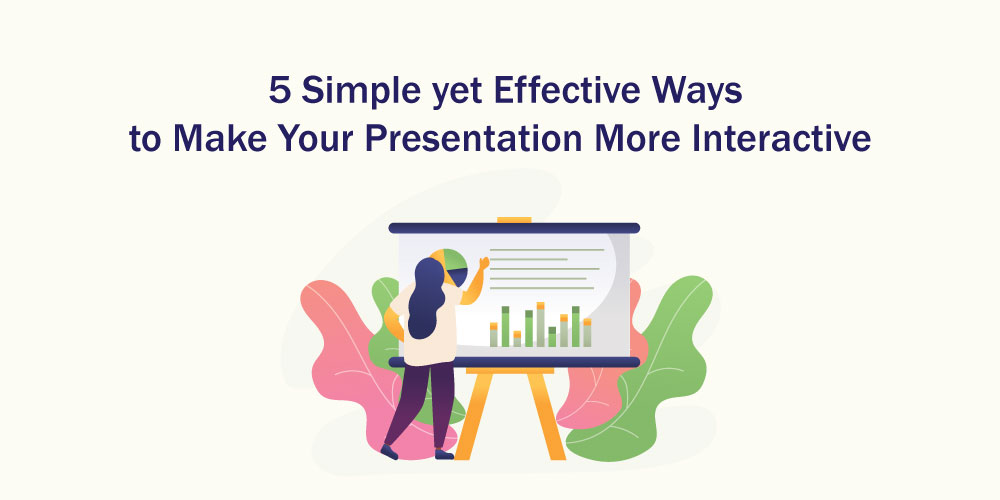There are multiple occasions in professionals’ lives when they must prepare and deliver presentations to decision-makers, stakeholders, and even large crowds. Creating a perfect slideshow requires knowledge, innovation, and a profound understanding of your audience’s minds. If your slides are jam-packed with data and facts and lack creative and interactive appeal, you will find your audiences’ attention wavering, their faces getting dull and sleepy, and their hands trying to reach their smartphones. And this very sight is enough to make a presenter’s motivation fall into pieces.
Many presenters believe that their primary job is done by completing a PPT and stuffing it with the required information. They often miss putting stress on how to captivate the audience’s attention by presenting interactive content. Increasing the viewers’ participation during a presentation through your communication and demonstration skills is essential, but without a well-curated PPT, all your efforts will go in vain.
In this article, we will discuss ways to make your next presentation interactive and engaging in order to connect with your audience on a deeper level.
1. Start with Enthusiasm
People come to attend a presentation in different moods. So, stay ready to shatter the clouds of thoughts that occupy your audience’s minds with your enthusiasm as soon as they settle on their seats. To reset their attention and bring their focus to your presentation, you can either start by telling a professional joke, asking a mind-blowing question or narrating a famous quote.
According to research, the attention span of today’s people is continuously decreasing. Therefore, to hook your audience for the rest of the presentation, you will need to use those initial minutes very smartly. An enthusiasm-filled start will not only warm up your audience but, at the same time, turn them into active participants.
2. Compel Your Audience with Stories
If your presentation is giving some classroom vibes, then you have significantly missed the true purpose of it. A presentation should sound and feel like a story. People can often watch movies, listen to podcasts, or read novels for hours. But a 30-minute slideshow can make them yawn if it lacks interactive ingredients.
There are several ways to weave a story around your topic, such as including anecdotes, business journeys, personal experiences, etc. You can also add other storytelling elements, like suspense, narratives, conflicts, and ups and downs in business. For instance, you can start with the inception of your firm in tough times and how it made it through. Then, slowly, you can connect it to the lives of your audience to spark their interest and make them want to hear more.
3. Add Images, Diagram, Graphics, and Videos
Using more text and fewer graphics in a presentation is a direct invitation to monotonousness and boredom. Moreover, just data and facts make it harder for your audience to retain the information for a long time. Sprucing up the content of your presentation by using videos, graphics, and vectors in appropriate places creates contrast and revives your viewers’ swaying attention. Some concepts are difficult to understand, and professionally-designed visuals are the perfect tool to communicate them simply.
Graphics and videos are also good if you want to reinforce your information and let people understand the concept more thoroughly. However, keep in mind not to overuse them. Otherwise, the length of your PPT will needlessly stretch.
4. Embrace the Power of Two-Way Communication
One common mistake amateur presenters often make is making the whole presentation session a one-way communication. During a presentation, several questions strike the audience’s minds. However, without the proper opportunities to ask, they soon turn into chunks of confusion, and their overall interest starts to drop.
To improve their understanding of the concept, clear their doubts about a fact, and keep them actively involved throughout the session, encourage them to ask questions by opening a welcoming space for discussion. And when they ask, praise them for their effort and politely resolve their queries.
5. Take Your Presentation a Notch Higher by Adding Physical Props
When your presentation is strictly about products, biology, scientific discovery, etc., then using props is the best way to let your audience understand your product through a live visual representation. With each slide, you can point to your prop to highlight a certain aspect. A prop is a suitable tool to take viewers’ attention away from the slideshow for a moment and give their tired minds a break.
Conclusion
Preparing a presentation to convey specific facts, information, or data is something everyone with a bit of knowledge of PowerPoint tools can do. However, designing it in a way that successfully binds the audience’s attention right from the start to all the way to the ‘thank you slide’ is something every presenter should aim to master. In a nutshell, preparing a presentation is more of an art than a skill.
Using the aforementioned ideas and tips, you can create a slideshow that isn’t boring or predictable. By thoroughly planning your presentation and placing data and visuals in a simple manner, you can provide your audience with sufficient time to understand the slides and ask questions. As a presenter, you should never forget that you have created this slideshow for your viewers. Hence, your body language, energy, contents of the slides, etc., should be in such sync that your viewers establish a deep bond with your presentation.
